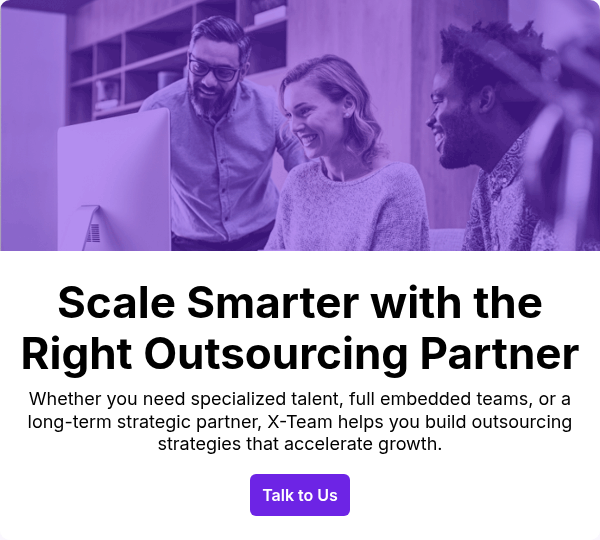
Outsourcing is one of the most effective ways to control operational costs, but that’s just the beginning. When it’s done right, a successful outsourcing strategy also gives you speed, focus, and the ability to scale.
The mistake most companies make? Treating outsourcing as a short-term fix. But the teams that grow fastest build it into how they operate by aligning external partners to core goals and freeing internal teams to focus where it counts.
This guide breaks down how to build an outsourcing strategy that lasts: from picking the right model to managing the relationship over time.
What Is an Outsourcing Strategy?
An outsourcing strategy is a deliberate operating model and governance framework that defines which capabilities stay in-house and which are delivered by external partners.
The core principle is focus on core competencies. Keep your defining work in-house, and delegate the rest to specialists who can deliver faster and smarter. When clarity meets collaboration, outsourcing stops being transactional and starts becoming a lasting competitive advantage.
Why Companies Use Outsourcing as a Business Strategy
- Close skill gaps in specialized domains (e.g., cloud, data, cybersecurity) where partners can deliver faster and at lower risk.
- Accelerate timelines without burnout.
- Operate across time zones seamlessly.
- Reduce hiring and compliance risk.
- Stay agile during rapid growth or seasonal spikes.
- Achieve cost reduction on non-core processes (e.g., back office, support).
Outsourcing Strategy Models
In modern organizations, outsourcing strategy functions as a layered system. It encompasses:
Delivery models
- Onshoring: Local partnership for frictionless communication and shared regulations. You trade reduced timezone complexity for higher cost but gain proximity and cultural fluency.
- Nearshoring: Regional collaboration within overlapping time zones. Nearshoring is ideal when iteration speed and cultural alignment matter.
- Offshoring: Global reach optimized for scale, cost, and 24/7 delivery. Offshore staff augmentation works best for well-structured processes and volume operations.
- Hybrid/multisourcing: Combination of models to balance cost, control, and flexibility. As your company evolves, this mix often becomes your most powerful lever.
Engagement Types
- Staff augmentation: External talent works under internal direction to flex capacity and fill skill gaps without shifting ownership. Nearshore staff augmentation, in particular, offers the added advantage of time zone alignment and cultural proximity.
- Managed services: Providers take accountability for defined outcomes with SLAs and performance metrics.
- Outcome-based contracting: Focuses on business results, not inputs. Ideal for partners embedded into delivery with shared KPIs.
Governance Mechanisms
- SLAs that define expectations and service levels.
- KPIs tied to quality, speed, and business impact.
- Escalation paths for issue resolution.
- Integration standards for shared tools, reporting, and decision-making.
Risk Frameworks
- Security protocols and data protection measures.
- Compliance with regional and industry regulations.
- IP protection and confidentiality safeguards.
- Transition plans for onboarding, offboarding or vendor replacement.
As organizations grow, their outsourcing strategies evolve from one-off transactions to portfolio-level design. That includes:
- Multisourcing: A few strategic partners plus niche specialists to balance efficiency with innovation.
- Service integration: Shared architecture, data standards, and tooling that enable coordination across multiple providers.
- Continuous rationalization: Regular performance reviews, cost-to-serve analysis, and alignment checks to ensure every vendor relationship supports evolving business goals.
In this model, outsourcing becomes a strategic discipline for business operations. It turns external partnerships into a durable source of leverage: accelerating delivery, expanding capabilities, and enabling internal teams to stay focused on the work that matters most.
How to Build an Effective Outsourcing Strategy
A strong outsourcing strategy is a system that’s designed to scale, adapt, and sustain your delivery momentum. These steps help you build a foundation that grows with your company.
Define Clear Objectives and Scope
Every strategy starts with clarity. Know what success looks like before you bring anyone else on board. Whether your goal is to accelerate delivery or expand expertise, your objectives dictate the scope, partner model, and metrics.
Think precision, not projection: Define desired outcomes, success metrics, and ownership before signing contracts.
Clarity at this stage prevents misalignment later. If you're outsourcing QA to speed up releases, the scope, timelines, and metrics should reflect that. If the goal is access to senior engineering talent, the focus should be vetting, retention, and integration.
Outsourcing strategy examples:
- A product-led SaaS company outsources Tier 1 customer support to keep internal teams focused on roadmap delivery.
- A media platform uses nearshore developers to reduce latency in content updates and ship features on time.
- A fintech firm offshores data annotation to scale up AI model training while controlling costs.
Identify Functions to Outsource vs. Keep In-House
Great outsourcing is built on focus. Core functions — your IP, your customer experience — stay internal. Non-core functions are essential but don’t differentiate, making them prime candidates for outsourcing.
Use a core vs. non-core framework to decide what can move out without losing momentum or failing to realize reduced costs. And revisit that map quarterly; what’s non-core today might become mission-critical tomorrow.
Examples of non-core functions can include:
- Infrastructure and IT support
- QA and testing
- Customer support
- Internal tools and admin workflows
Treat this as a dynamic process, not a fixed decision. As your business evolves, so should your outsourcing map.
Choose the Right Outsourcing Partner
Outsourcing success hinges on partner selection. The wrong fit creates delays, misalignment, and churn. But the right partner aligns with your culture, cadence, and commitment.
Key criteria to consider when evaluating an outsourcing company:
- Proven expertise in your domain.
- Cultural and communication alignment.
- Transparent onboarding and integration.
- Retention and team stability
The choice of in-house vs. outsourcing software development is usually more than just access to specialized skills. It’s about how well your partner integrates, communicates, and adapts.
Set Up Communication & Collaboration Systems
Communication and customer service excellence are the backbone of successful outsourcing. Build shared systems that prioritize visibility, accountability, and async-friendly workflows.
Build your stack around visibility and feedback. That includes:
- Shared dashboards for performance tracking
- Regular check-ins with clear agendas
- Defined KPIs for each outsourced function
- Async-friendly tools that support different time zones
Make sure everyone knows who owns what and how decisions get made.
Manage the Relationship Proactively
Outsourcing services isn’t a handoff. It’s an ongoing partnership built on proactive risk management and clear accountability.
Establish:
- Service-level agreements that define expectations, response times and clear project management ownership.
- Escalation paths for handling blockers or misalignment.
- Feedback loops for continuous calibration.
When problems arise — and they will — the process matters more than being perfect. Good partners won’t wait for instructions; they’ll proactively bring you problems and proposed solutions.
Continuously Improve & Adapt the Strategy
Growth never stands still, and neither should your outsourcing model.
Build in quarterly reviews to evaluate:
- Are the right functions still being outsourced?
- Is the partner keeping pace with your needs?
- Are new technologies (AI, automation) changing what’s possible?
Use these checkpoints to adjust scope, reset goals, or explore new delivery models. Keep your strategy adaptive to make it a long-term asset.
Outsourcing as a Growth Strategy
The best outsourcing strategies go beyond cost-cutting to increase leverage, keep internal teams focused, speed up delivery, and reduce operational drag.
Whether you’re offloading infrastructure, adding product squads, or scaling customer support, the real differentiator is the team behind the outsourcing strategy. That’s why companies turn to partners like X-Team.
X-Team is the right partner for outsourcing software development to give you clarity and capacity to drive momentum.
TABLE OF CONTENTS




